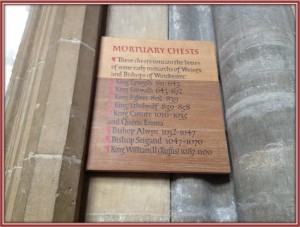Last week archaeological authorities in England’s north announced that indeed, the skeleton found last summer underneath a municipal car park in Leicester is that of the notorious King Richard III. Now on the heels of this discovery, a team of archaeologists from the University of Winchester down in England’s southern Hampshire are hoping to discover the bones of Saxon England’s 9th century King, Alfred of Wessex believed to be buried in St. Bartholomew church in Hyde, located a little north of Winchester.
The saga of Alfred’s tomb is a complex one with enough twists and turns of which medieval mystery writers dream. According to various resources, Alfred was originally although temporarily, buried in Winchester’s old minster upon his death on October 26, 899 AD. However, about 903 AD, a new minster was built and consecrated next door and at that point, Alfred’s remains were moved to the New Minster; but this move proved to be another temporary one.
Roughly about 1109 AD, King Henry I ordered the New Mister to be moved north of the city to the suburb of Hyde Mead. When the new ‘abbey church’ of Hyde was consecrated in 1110 AD, the bodies of Alfred, his wife Ealhswith and his son Edward the Edler, were interred before the high altar…until Henry VIII’s rampage against the monasteries and abbeys in 1539.
Amazingly, although the abbey church was demolished by Henry’s enforcers, the graves of several royals were left intact only to be accidentally discovered in 1788 during the construction of a prison on the old abbey site. As often happened in such instances, the tombs were robbed, the bones scattered. One of the stories that continues to persist is that a vicar ‘bought’ Alfred’s bones, although from an ‘unreliable’ source, and moved them to St. Bartholomew. Anything is possible of course; the bones could be Alfred’s, although the sale of suspect ‘relics and artifacts’ is a practice that dates back thousands of years and remains so today…often under the guise of ‘lost’ art that turns out to be expertly forged!
If permission for the excavation is given, radio carbon dating will be used to determine the bones authenticity and if it’s proven that they are the bones of England’s greatest king, experts agree that this would be one of the most significant archaeological discoveries ever made. Stay tuned!

Photography©Gaye F. Mack, Inc.
PARTIAL LIST OF BONES BELONGING TO ENGLAND’S SAXON KINGS AND BISHOPS BELIEVED TO BE CONTAINED IN THE MORTUARY CHESTS AT WINCHESTER CATHEDRAL
You can follow me on, https://www.facebook.com/gayemackauthor, https://www.linkedin.com, https://www.twitter.com/gayemack or https://gayemack.com

I would very much like it to be Alfred, but gaining anything like proof will be beyond the historians, I fear. They may be able to indicate the age, and they may get as far as showing that these were some of the bones that we plundered, but since they were taken in shady circumstances, I don’t see how there can be proof that it was Alfred, especially as there’s no chance of establishing a DNA link, I believe. Winchester, of course, was a hanging prison; strange to think that all those murderers buried in unmarked graves might have been close to royalty!
Thanks for the comment, Malcolm…I read something in the last few days either on Facebook or it might have been Twitter posted by a man who says his wife is a great niece(waaaay down the line obviously) of Alfred’s and that she was willing to offer her DNA…now my question is how in the world could someone ‘know’ this when we’re talking the lapse of 1100 years?…seems a bit far fetched when record keeping in those days wasn’t always the best…even if they could be read…